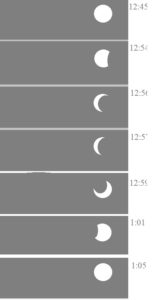Pinhole Viewer for Eclipse
Re: August 21 eclipse event (at Keota High School).
To: Keota High School Teachers and Staff
From: John Honeycutt, Teacher

My wife (Jennifer) and I have assembled a few dozen pinhole viewers for our Keota high school students to experience – assuming their instructor (and others) approve and supervise.
I will be located near/around the outside basketball court beginning 12:35 (after lunch) on Monday, August 21.
Rules:
The first rule of enjoying the eclipse is to never look directly at the sun. Certainly never look at the sun through a telescope or binoculars without proper filters.
Even when most of the sun’s surface is blocked during the partial phases of a solar eclipse, the remaining, visible crescent is intensely bright and cannot be safely viewed without eye proper protection. While some teachers may have appropriate eye wear for students – I will not be providing this. I will only be providing “Old School” pinhole viewers.
What to Expect:
Below is a time-sequence illustration (approximation) of the shadow that will be cast on the “floor” of the pinhole viewer boxes. I do not know the precise timing of the event for our area. My best estimate is that it will “peak” at around 1:00 pm Central for Keota. The sequence below is truly illustrative only – so that students may have a reasonable expectation of what the pinhole viewer is – and is not.

How to Use the Box:
- Hold box in front of you. Standing with one’s back toward the sun (it will be approximately overhead – but stand so that your shadow falls directly in front of you – hold the box in front of you. “Point” the box toward the ground.
- Peer into to exposed top of box. Lift the exposed opening at the top of the box toward your eye. Look downward into the box – toward the bottom of the white paper “floor” of the box. This is sort-of like looking into a microscope.
- Adjust the angle of the box. Aim the pinhole located at the top of the box the toward the sun. The sun will shine through the small “circle” hole puncturing the aluminum foil. Adjust the angle of the box so that the sunlight “shines” through the pinhole to make a bright light on the pinhole viewer’s floor.
- Watch the small circle of light. Confirm the light displaying on the floor of the box is an “almost” circle. (Note: the openings we made in the aluminum foil are not perfectly round, so the light will not be perfectly round either).
There are only 45 boxes (pinhole viewers) – so if the student count is more than this, the students will need to gently share them – I suggest allowing 10-15 seconds at most, then pass the viewer to a student-partner. Then pass it back after 10-15 seconds. The aluminum foil is fragile – so please advise students to gently share the boxes.
What Else to Expect:
For those not using a viewer, but just standing outside (but NOT looking at the sun) … the temperature will likely drop slightly (probably enough to feel). At the 100 percent locations, the temperature will drop by up to eight degrees F. For Keota, it will likely drop only two or three degrees at most, but the decreased light combined with decreased solar energy will combine to give a sensation of temperature drop. Also, there may be an odd coloration of everything for a brief period.
Thanks.
John.
ps. Thanks to Federal Express and Dillards in Fort Smith for donating about two dozen boxes each. This post adapted from article in Washington Post.

